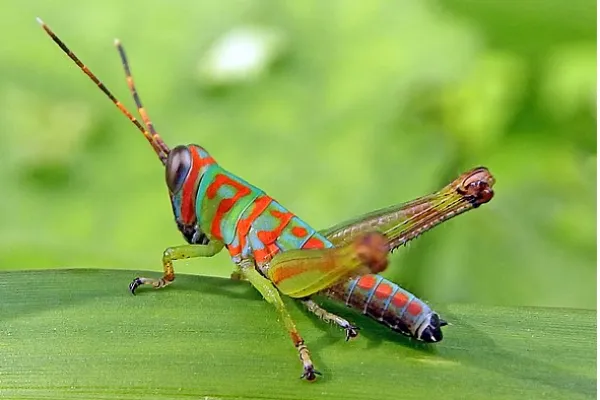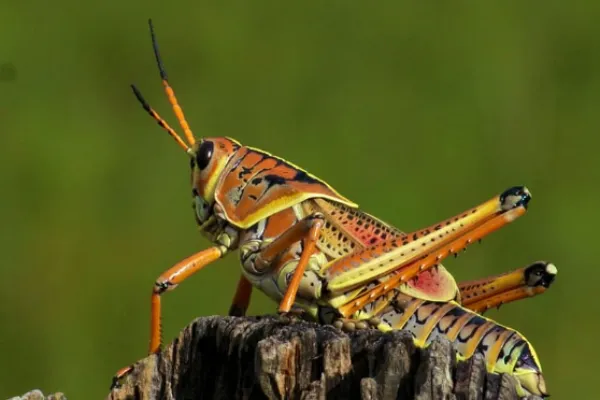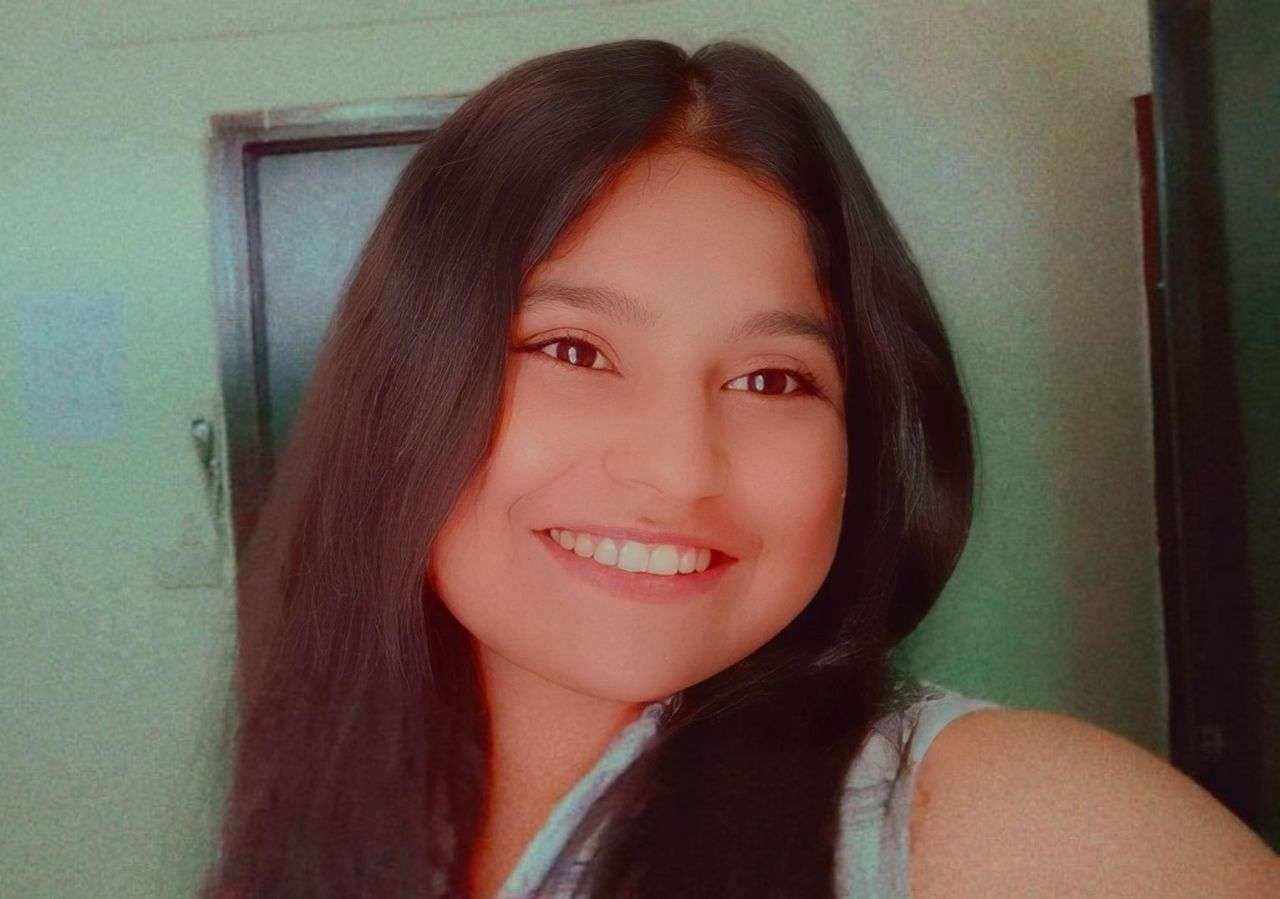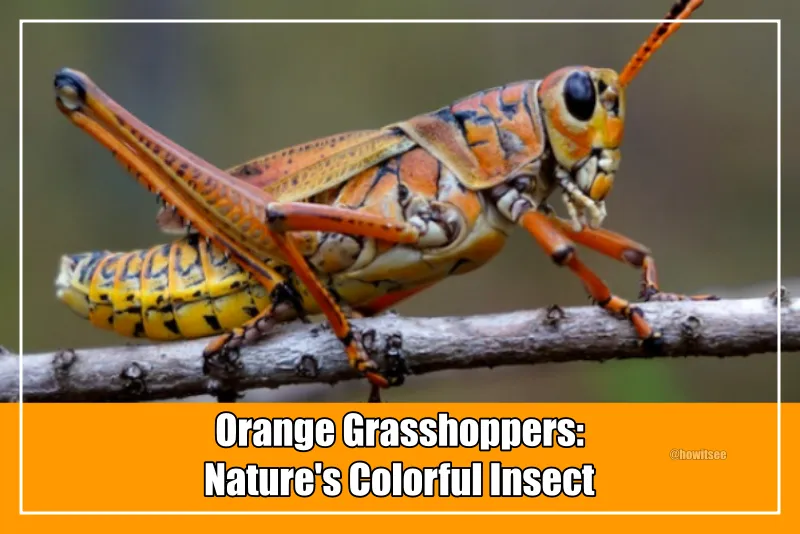We are back with the new article on grasshoppers. In previous articles, you must have seen different types of grasshoppers. But have you ever seen an orange grasshopper?
These grasshoppers are very rare, found in selected areas across the world. They are known for their rare coloration and distinctive features.
If you are curious to know about these fascinating orange creatures, then this article is for you! In this article, we are going to look at characteristics of these insects.
10 Orange Grasshoppers
1. Little Clown grasshopper

| Scientific name | Chromacris colorata |
| Size | 1.5 inched |
| Location | In southeast Asia, India and Sri Lanka |
| Identification | Blue body with orange strips |
This little clown grasshopper is widely distributed in southeast Asia, India, and Sri Lanka. They are commonly named so because of their clown like appearance. They have a remarkable blue body with orange strips.
You can find the nymphs of this grasshopper more colorful than the adults. This herbivore species is very famous among insect photographers due to its clownish coloration and behavior.
2. Red Orange Grasshopper

| Scientific name | Titanacris dux |
| Size | 2-3 inches |
| Location | Peru |
| Identification | Huge orange hindwings |
This red-orange grasshopper belongs to the family of lubber grasshoppers. This Peruvian native insect is one of the largest grasshoppers in the world, inhabiting rainforests. They are known for their unique and largest wingspan, which is around 6 inches.
They have a brownish body with huge orange hindwings and black legs. Their hues are warning signs for predators. If you love to collect insects, then it must be one of them.
3. Florida Giant Orange Grasshopper

| Scientific name | Romalea guttata |
| Size | 4 inch |
| Location | Florida |
| Identification | Colorful body with red, orange and yellow markings |
This one is also from the family of lubber grasshoppers. These poisonous grasshoppers have aposematic coloration to make the predators Stay away from them.These flightless grasshoppers can attain a size upto 4 inches.
One can found them crawling in Florida. They are not so picky when it comes to food but they are voracious feeders. This Romalea guttata has colorful body with enchanting red, orange, yellow colors which make them beautiful.
4. Chameleon Skyhopper
| Scientific name | Kosciuscola tritis |
| Size | 1 inch |
| Location | Australia |
| Identification | Bluish body with orange Hindlegs |
This grasshopper is unique, whether in its name or characteristics. This grasshopper is named the “chameleon skyhopper” due to its ability to change color and to jump up to 10 times its body length.
This Australian native species is listed as a vulnerable species. Their features help them avoid predators. It has a bluish body with orange hindlegs and a body size of 1 inch. Their body color is controlled by the temperature of their surroundings.
5. Leichhardt’s Grasshopper

| Scientific name | Petarida ephippigra |
| Size | 1-1.5 inches |
| Location | Australia |
| Identification | Bright orangish red body with significant black and blue patches |
You might have heard about this grasshopper in previous articles. This is known for its distinctive appearance. This endemic species of Australia has the ability to jump up to 20 times its own body size.
They have a bright orange-red body with black markings. This tropical savvanah-inhabiting species is named after the explorer Ludwig Leichhardt.
6. Orange Legged Grasshopper
| Scientific name | Spharagemon equale |
| Size | – |
| Location | Western United States, Canada |
| Identification | Have orange hind tibia |
They are widely distributed in the western United States and Canada, inhabiting grasslands and desert prairies. This polyphagous species feeds on a variety of grasses and shrubs.
known as the “orange-legged grasshopper” due to the presence of an orange hind tibia. They go through five instar stages to become adults.
7. Packard’s grasshopper
| Scientific name | Melanoplus packardii |
| Size | 1.5-2 inches |
| Location | North America |
| Identification | Brownish body with orange and yellow markings |
In this list, another orange grasshopper is Melanoplus Packardii. This spur-throated grasshopper species is native to North America. Adults of this species have a body size of 1.5 to 2 inches.
They have peculiar coloration; they have a brownish body with orange-yellow markings. They are known to be pests of many crop species. Nymphs can be easily differentiated from adults by their green color and short wing size.
8. Woodland Grasshopper
| Scientific name | Omocestus rufipes |
| Size | 11-22 mm |
| Location | Europe, in the palearctic realm and North America |
| Identification | Have orange colored abdomen apex |
This species is named rufipes which means “red-footed,” due to its characteristic red foot. One can find this species in Europe, in the palearctic realm, and in North America.
Females tend to be larger than males. (females: 13–22 mm; males: 11–17 mm) They have a brownish body with a white edge on the pronotum. Adults have an orange-colored abdomen apex. This woodland inhabiting species is quite noisy.
9. Blue Green Grasshopper
| Scientific name | Caryanda spuria |
| Size | 1-2 inches |
| Location | Singapore, Indonesia and Malaysia |
| Identification | Have blue orange body with distinctive orange antennae |
This grasshopper is known for its extraordinary appearance. They have a blue-orange body with remarkable orange antennae. Their body sizes range up to 1-2 inches.
Their wings are blue due to the presence of blue iridescent pigment. This herbivorous grasshopper is harmless to crops. If you are an insect lover and want a pet, then this one is best for you!
10. Rufous Grasshopper
| Scientific name | Gomphocerippus rufus |
| Size | 14-22 mm |
| Location | Europe and in palearctic realm |
| Identification | Red brown body with orange abdomen apex |
Europe and the Palearctic realm are home to members of the family Gomphocerinae, known for their red brown coloration with orange apex of abdomen and medium size, ranging up to 14-22 mm.
They are not considered as pests but harmful for livestock, as they transmit diseases. This diurnal insect is a good flier and can migrate to large distances.
Conclusion
This world is full of surprises, and a lot of them need to be revealed. Insects are known to have huge diversity, and grasshoppers are one of them. Thousands of species, differing in size, color, and other characteristics, have evolved incredibly in these fascinating creatures.
These orange grasshoppers are quite rare in nature. They have evolved in such a way that they can use their coloration to blend in with the environment and avoid predators. and also cryptically warn them to stay away. This is not the end; there are a lot of surprises this animal kingdom has for us!
Also Read:

Being a zoology student I’m always been fascinated toward animals especially insects. I love to do research and learn about different animals. As a writer I want to share my thoughts about nature through my articles. Apart from this you can find me exploring the new places and voice notes.
